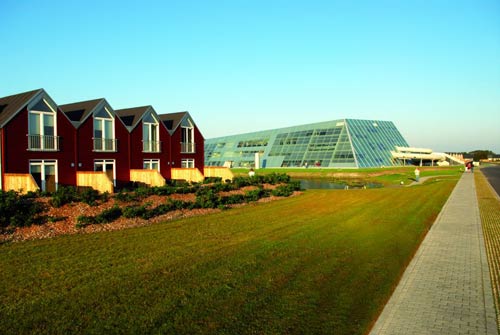Laid-back on the Danish coast
The serene shores of Jutland, home to a new holiday resort, gives the Med a run for its money, says Mark Hillsdon

Your support helps us to tell the story
From reproductive rights to climate change to Big Tech, The Independent is on the ground when the story is developing. Whether it's investigating the financials of Elon Musk's pro-Trump PAC or producing our latest documentary, 'The A Word', which shines a light on the American women fighting for reproductive rights, we know how important it is to parse out the facts from the messaging.
At such a critical moment in US history, we need reporters on the ground. Your donation allows us to keep sending journalists to speak to both sides of the story.
The Independent is trusted by Americans across the entire political spectrum. And unlike many other quality news outlets, we choose not to lock Americans out of our reporting and analysis with paywalls. We believe quality journalism should be available to everyone, paid for by those who can afford it.
Your support makes all the difference.The west coast of Jutland is one long stretch of golden sand, backed by dunes, heathland, and big, big skies. It seemed the perfect solution to our search for an alternative to the Med for a family holiday. And by swapping cheap flights for an overnight ferry to Esbjerg, we'd taken a greener option, too.
The crossing from Harwich to Esbjerg takes 18 hours, although it wasn't aboard the "floating city" I'd described to Lauren, nine, and her five-year-old sister, Hannah. Apart from a small gift shop and a row of (thankfully) out-of-order arcade games, you need to make your own on-board entertainment. But the food was excellent and our cabins comfy.
Next morning, within a couple of hours of docking, we'd driven up the coast to SeaWest, one of the country's newest holiday resorts. The Danes love their holiday homes and many of the fishing shacks along the North Sea coast have been reclaimed as weekend retreats. The wooden chalets at SeaWest reflect this local architecture, although, with typical Danish élan, they have added stylish touches such as paintwork in muted tones of blue and green, and whirlpool baths as standard.
A huge glass wedge – the Transparent Dune – houses a swimming pool with wave pool and choice of water slides, and there's a range of sports from crazy golf to ten-pin bowling, as well as a kids' soft-play area. And that's where I sat as mum took advantage of the gym, wellness centre and a full-body massage. You can eat on site too, although the pizzeria is uninspiring, and we gave the grill a miss, choosing to use our well-equipped kitchen and barbecue instead.
The silence and solitude of Jutland are striking: you can drive for miles without coming across another car, and there are more wind farms than people in the countryside.
At Norre Nebel, a sleepy town just a few minutes from our chalet, we hired strange contraptions called trolley cycles, which run along a disused railway line through the Blaabjerg plantation and down to the coast at Nymindegab. Going downhill, with the wind behind you, is exhilarating; coming back uphill into anything more than a light breeze, and your thighs are soon screaming for mercy.
The beach at Nymindegab is vast, stretching as far as the eye can see in both directions, not unlike the beaches on England's north-west coast. Apart from a small, seasonal ice-cream kiosk, the place is virtually deserted – but with shells, space and the macabre sight of hundreds of small jellyfish stranded on the beach, the kids were happy.
Further up the coast is the Ringkobing fjord, although it was nothing like the fjords I remember from O-level geography; there was no narrow inlet or steep craggy cliffs, just a vast bowl of water, cut off from the North Sea by a thin strip of land, and full of dinghies and windsurfers.
At Henne Strand we found another vast strip of sandy shoreline, with all the mod cons of a bustling seaside town. Reassuringly, most of Jutland's beaches are Blue Flag, but it's worth remembering that they're all lapped by the North Sea, and only the bravest try the icy waters.
Another unspoilt spot is Vejers Strand, where the dunes are dotted with holiday homes, many with grass roofs, so that the only sign they are even there are wispy trails of smoke drifting from hidden chimneys.
During the Second World War, Denmark's long, flat west coast was considered a natural choice for an Allied invasion, and a string of German gun emplacements was built along the shore. Many have been destroyed or submerged under drifts of sand, but the Tirpitz Battery, near Blavand, Denmark's most westerly point, proved impossible to tear down. The concrete fort is now home to a small museum, and it's worth a visit for an insight into what the Germans had planned had the Allies chosen Jutland over Normandy.
On the way back to Esbjerg we stopped off to see Man Meets the Sea, four striking white figures that we'd seen earlier from the ferry. And these vast statues, staring into the distance, seemed a fitting tribute to Jutland, its serenity, and its laid-back take on life.
COMPACT FACTS
How to get there
Mark Hillsdon and family travelled to Denmark as guests of DFDS Seaways (0871 882 0886; dfds.co.uk). The price for two adults and two children sharing a four-berth inside cabin costs from £708 in high season. A week's accommodation in a six-berth chalet at SeaWest starts at £634 (00 45 70 23 2030; strandhotellerne.dk).
Join our commenting forum
Join thought-provoking conversations, follow other Independent readers and see their replies
Comments